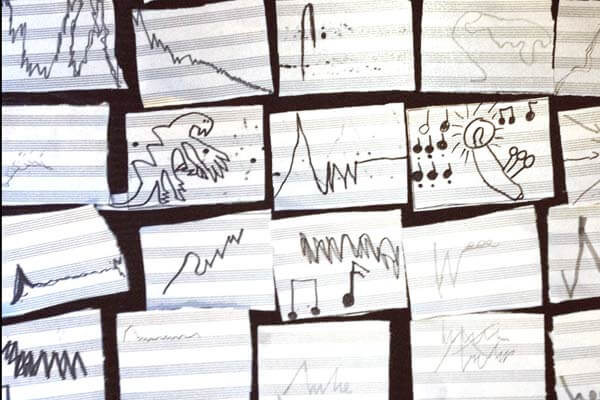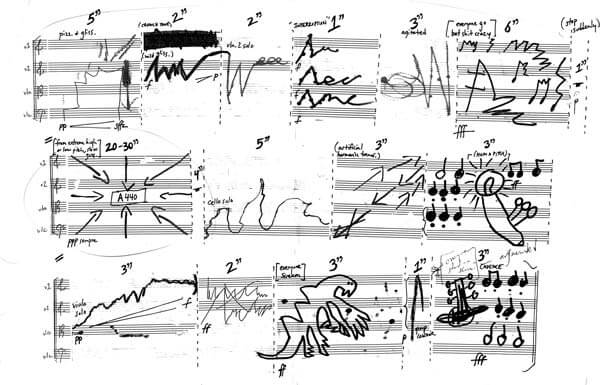I suppose I should open with a disclaimer: I am a composer, by no means an expert on music education, and am not particularly well read in the area of pedagogy. I am writing this little article because, in the words of J.S. Bach (as paraphrased by Kyle Gann), “I had a gig.” And yet I would have never imagined that in the pursuit of writing an engaging tune for string quartet I could have stumbled across as much food for thought as I did. In short, my search for a good 3-minute piece culminated not in the discovery of a snazzy riff or a harmonic progression that I found particularly cool but it came, instead, from a few notes by Beethoven and a room full of third graders.
But let me backtrack just a little – the previously mentioned gig in question came from a friend, Nick Benavides, who serves on the board of a Bay Area non-profit called Composers and Schools in Concert (CSIC). The piece was to be premiered as part of a holiday fundraiser for the organization in a short set featuring new tunes by Nick and myself played by a local group called Friction Quartet.

Friction Quartet
Right off the bat, I began trying to figure out what in the world one could do in 3 minutes. I settled on the idea that it would be interesting to somehow cram those minutes with as much musical information as possible. I began to brainstorm about the possibility of making a micro-collage that offered a bunch of different perspectives on a single idea. This in turn led me to the possibility of creating a way to crowd-source material that I didn’t write myself, turning my own role more of a curator and arranger. It then seemed only logical, given the context (a benefit for an educational organization) and medium (a string quartet), that I somehow try to write a piece that integrated those elements as directly as possible – by having a group of kids graphically notate their own interpretations of a string quartet and have the piece be a reading of their selected notations.
On a cold, rainy San Francisco morning in November 2012, I visited a classroom at West Portal Elementary School. Equipped with a stack of blank staff paper and a pile of markers, the group of 20-some kids and I talked about how we would go about drawing the sounds we hear to produce a musical score, and – perhaps more importantly – that a score can be anything if you feel that it represents the sounds you hear (or, rather, want to hear). After a few warm-up exercises, I played for them a few snippets from some late Beethoven quartets. I tried to stick to excerpts that were fairly straightforward yet had a clear, emotional weight, even if the feelings themselves were ambiguous or complex. The one that stuck out for them in particular was the declamatory opening section of the Grosse Fuge, Op. 133. We listened through it once, talked about exactly what we heard, and discussed what the character of the music felt like. After another listen, and accompanied by a little bit of background on the excerpt and the piece itself, we were able to draw out some concepts to inform our scores – in particular the idea of an overture (as the opening section is marked) as an important announcement and a call to listen. All in all each child had three listens of each excerpt and ample time to ponder and refine their interpretations. When I finally collected all of the scores (with a little bit of difficulty – I had to assure many that they’d not only get them back, but when they did they would be performed composers!) I was truly amazed by their results.

In my first and perhaps only real compositional move, I began to create a sequence for the drawings – ranging from squiggles to dinosaurs to objects whose identity are still up for debate1 – with only one limitation: that I was to find a way to use at least one drawing by every child. As I began to experiment with orderings of the scores, I developed my own affinities for certain ones and placed them accordingly. I then began developing a feel for how the overall collage would pace out and wrote out rough duration values for each drawing.
The final major phase of the project (finally christened with the title 27 Overtures2) involved figuring out how the thing would actually sound. At the advice of my teacher, Dan Becker, I sat down with Friction Quartet for a cold read-through of my ordering of the scores, without any further annotations. Friction, a fantastic group of players who are unflinchingly ready to tackle any musical challenge placed on their stands, were instrumental (ha!) in developing ideas about how to actually realize each of the scores. After a session of playing and brainstorming, I further marked up the drawings with ideas about dynamics, playing techniques and instrumentation.

The end result was, in my opinion, far more interesting and exciting than anything I could have possibly written myself. While the majority of the work was not directly musical in nature and substantially more involved than sitting at the piano or computer and whistling away a cool tune, I fully believe it was worth the extra sweat. Instead of writing a decent 3-minute piece for string quartet that left people mildly amused (at best!), a project emerged that directly affected people. A group of third graders not only learned a little bit about Beethoven and the crazy world of graphically notated music, but they became performed composers; a string quartet learned how to play a dinosaur on their instruments; and a composer learned that sometimes the best way to create something meaningful is to offer questions instead of answers.
–
Danny Clay is a composer and general noise-maker based in San Francisco, California.
1 One in particular I’m pretty certain is a trumpet, although my teacher, Dan Becker, asserts it is a spaceman.
2 For the record, it wasn’t until afterward that I realized I might be making an unintentional reference to a Katherine Heigl flick. Mea culpa, kids.





















